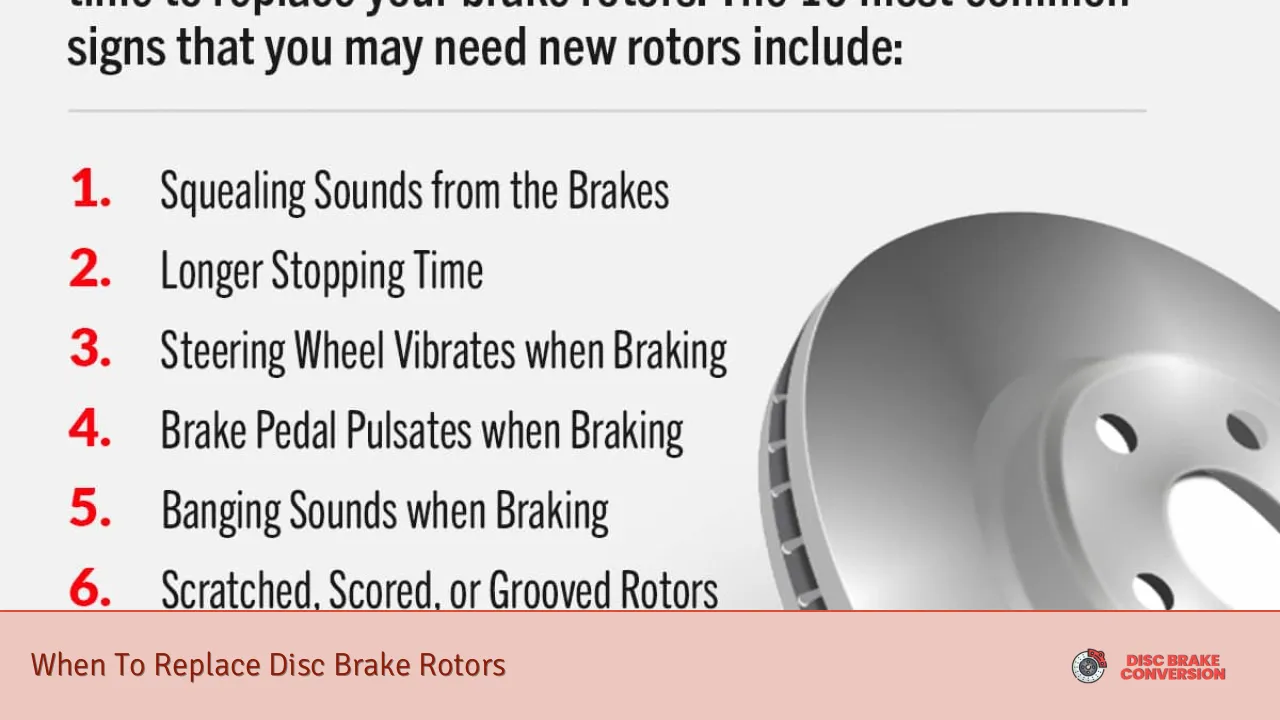Knowing when to replace disc brake rotors is crucial for maintaining vehicle safety and performance. Disc brake rotors are essential components of a vehicle’s braking system, providing the surface against which brake pads clamp to slow down or stop the vehicle. Over time, these rotors can wear out or become damaged, leading to reduced braking efficiency and increased stopping distances. This article will guide you through the signs of wear and tear, recommended replacement intervals, and important considerations for ensuring your braking system remains effective.
Aspect Details Function Provides a surface for brake pads to clamp against Common Issues Warping, cracking, excessive wear
Signs That Indicate Rotor Replacement
Recognizing the signs that your disc brake rotors need replacement is vital for your safety. Several indicators can signal that it’s time to replace your rotors:
- Squeaking or Squealing Noises: If you hear unusual sounds when applying the brakes, it may indicate that the brake pads are worn down and causing metal-to-metal contact with the rotor.
- Vibrations or Pulsations: If you feel vibrations in the brake pedal when braking, it could mean that the rotors are warped or unevenly worn.
- Longer Stopping Distances: If you notice that your vehicle takes longer to stop than it used to, this may be a sign of rotor wear or degradation.
- Visible Damage: Inspect your rotors for grooves, cracks, or discoloration. Any visible damage is a strong indicator that replacement is necessary.
- Thickness Measurement: Most manufacturers specify a minimum thickness for rotors. If your rotor’s thickness falls below this threshold, it must be replaced to ensure safe braking performance.
Regular inspections can help catch these issues early. It’s advisable to check the condition of your rotors during routine maintenance or whenever you replace brake pads.
Recommended Replacement Intervals
The lifespan of disc brake rotors can vary significantly based on several factors including driving habits, vehicle type, and environmental conditions. Generally, rotors should be replaced every 30,000 to 70,000 miles, but this can depend on:
- Driving Style: Aggressive driving with frequent hard stops can lead to faster wear. Conversely, smooth driving can extend rotor life.
- Type of Vehicle: Heavier vehicles or those used for towing may experience more rapid rotor wear than lighter vehicles.
- Environmental Conditions: Driving in wet or corrosive environments can lead to rust and corrosion on rotors, necessitating earlier replacement.
Monitoring your vehicle’s performance and being aware of how these factors affect your brakes is essential for maintaining optimal safety.
Importance of Pair Replacement
When replacing disc brake rotors, it’s crucial to replace them in pairs (front or rear) rather than individually. This ensures balanced braking performance across both wheels. Replacing only one rotor can lead to uneven braking forces which may cause instability while driving.
Additionally, always pair new rotors with new brake pads. This combination helps ensure that both components work effectively together from the start, optimizing braking performance and longevity.
Visual Inspection Techniques
Performing a visual inspection of your disc brake rotors can help identify potential issues before they become serious problems. Here are some tips for conducting an effective inspection:
- Check for Grooves and Cracks: Run your fingers along the surface of the rotor to feel for grooves or cracks. Any significant imperfections may indicate that the rotor needs replacement.
- Look for Rust: Surface rust is common but excessive rust can compromise rotor integrity. If rust appears deep or widespread, consider replacing the rotor.
- Measure Thickness: Use a caliper to measure the rotor thickness at multiple points around its circumference. If any measurement falls below the manufacturer’s minimum specification, replacement is necessary.
- Inspect for Heat Spots: Discoloration from excessive heat can indicate overheating issues which may affect braking performance.
Regularly inspecting your brake components will help ensure they remain in good working order and allow you to address problems before they escalate.
Professional Assessment and Replacement
If you’re uncertain about the condition of your disc brake rotors or lack the tools for inspection, seeking professional help is advisable. A qualified technician can provide a thorough assessment and recommend whether replacement is necessary based on their findings.
When opting for professional service:
- Ensure that they check both rotors and pads.
- Request that they measure rotor thickness.
- Ask about any visible signs of wear or damage.
Professional assessments not only provide peace of mind but also ensure that all components of your braking system are functioning correctly.
FAQs About When To Replace Disc Brake Rotors
- How often should I replace my disc brake rotors?
Typically every 30,000 to 70,000 miles depending on driving habits. - What are common signs that my rotors need replacing?
Squeaking noises, vibrations during braking, and visible damage. - Can I replace just one rotor?
No, always replace rotors in pairs for balanced performance. - Why is it important to replace pads with new rotors?
New pads ensure optimal contact and performance with new rotors. - How do I visually inspect my rotors?
Look for grooves, cracks, rust, and measure thickness with calipers.
In conclusion, understanding when to replace disc brake rotors is essential for safe driving. By recognizing signs of wear, adhering to recommended replacement intervals, performing regular inspections, and seeking professional assistance when needed, you can maintain effective braking performance and enhance overall vehicle safety. Always prioritize safety by ensuring that both your rotors and pads are in optimal condition before hitting the road.

